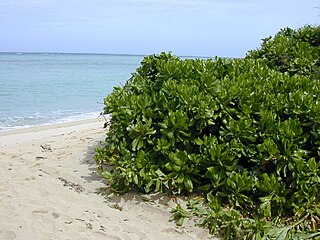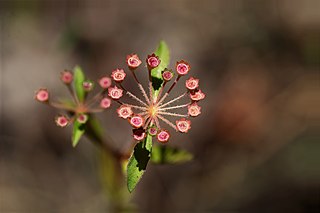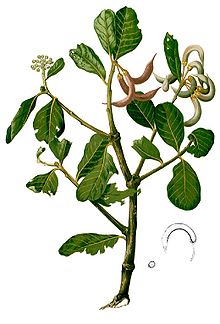
Xylomelum is a genus of six species of flowering plants, often commonly known as woody pears, in the family Proteaceae and are endemic to Australia. Plants in this genus are tall shrubs or small trees with leaves arranged in opposite pairs, relatively small flowers arranged in spike-like groups, and the fruit a woody, more or less pear-shaped follicle.

Rhipsalis is a genus of epiphytic flowering plants in the cactus family, typically known as mistletoe cacti. They are found in parts of Central America, the Caribbean and northern regions of South America. They also inhabit isolated locations in Africa and Asia, and are the only cactus group naturally occurring in the Old World. This is the largest and most widely distributed genus of epiphytic cacti.

Rhizophora is a genus of tropical mangrove trees, sometimes collectively called true mangroves. The most notable species is the red mangrove but some other species and a few natural hybrids are known. Rhizophora species generally live in intertidal zones which are inundated daily by the ocean. They exhibit a number of adaptations to this environment, including pneutomatophores that elevate the plants above the water and allow them to respire oxygen even while their lower roots are submerged and a cytological molecular "pump" mechanism that allows them to remove excess salts from their cells. The generic name is derived from the Greek words ριζα (rhiza), meaning "root," and φορος (phoros), meaning "bearing," referring to the stilt-roots.

Melaleuca armillaris, commonly known as bracelet honey myrtle, is a plant in the myrtle family, Myrtaceae, and is native to South Australia, Victoria and Tasmania in south-eastern Australia. It is a hardy, commonly grown species, often used as a fast-growing screen plant, but it also has the potential to become a weed. It has become naturalised in Western Australia and parts of Victoria. In its natural state, it grows on coastal cliffs and along estuaries.

Heritiera littoralis, commonly known as the looking-glass mangrove or tulip mangrove, is a mangrove tree in the family Malvaceae native to coastal areas of eastern Africa, Asia, Melanesia and northern Australia. The common name refers to the silvery appearance of the underside of the leaves, resembling a mirror to some degree. The strong timber has uses in marine applications and elsewhere.

Corniculate, an Anglicisation of the Latin diminutives corniculata, corniculatum, and corniculatus, describes an object possessing hornlike extensions. The root is Latin cornu = "horn". The term is used to describe the shape of the corniculate cartilages of the larynx. The horned puffin is named for its distinctive horn-like coloration. Likewise Oxalis corniculata is named for its two erect capsules, which resemble little horns, and the bird's-foot trefoil Lotus corniculatus and goat's horn mangrove Aegiceras corniculatum are named for their horn-shaped fruits.

The mangrove honeyeater is a species of bird in the honeyeater family Meliphagidae. The species was once considered to be conspecific with the varied honeyeater, but it is now treated as a separate species. These two species form a genus with the singing honeyeater.

Corymbia gummifera, commonly known as red bloodwood, is a species of tree, rarely a mallee, that is endemic to eastern Australia. It has rough, tessellated bark on the trunk and branches, lance-shaped adult leaves, flower buds in groups of seven, creamy white flowers and urn-shaped fruit.

Melaleuca viminalis, commonly known as weeping bottlebrush or creek bottlebrush, is a plant in the myrtle family Myrtaceae, and is endemic to New South Wales, Queensland and Western Australia. It is a multi-trunked, large shrub or tree with hard bark, often pendulous foliage and large numbers of bright red bottlebrush flowers in spring and summer. It is possibly the most commonly cultivated melaleuca in gardens and its cultivars are often grown in many countries.

Eleusine is a genus of Asian, African, and South American plants in the grass family, sometimes called by the common name goosegrass. One species (Eleusine indica), is a widespread weed in many places. Another species Eleusine coracana, is finger millet, cultivated as a cereal grain in India and parts of Africa.

Elaeocarpus angustifolius is a species of flowering plant in the family Elaeocarpaceae and occurs from India to New Caledonia and northern Australia. Common synonyms are E. ganitrus and E. sphaericus. It is a large evergreen tree, often with buttress roots, and has leaves with wavy serrations, creamy white flowers and more or less spherical bright blue drupe fruit. In English, the tree is known as utrasum bean tree in India. In Sri Lanka recorded names are woodenbegar and Indian bead tree. It is simply known as elaeocarpus in the Northern Territory of Australia. Other names used for this tree in Australia are Indian oil fruit and genitri. In Hawaii it is known as a blue marble tree.

Melaleuca viridiflora, commonly known as broad-leaved paperbark, is a plant in the myrtle family Myrtaceae, and is native to woodlands, swamps and streams in monsoonal areas of northern Australia and New Guinea. It is usually a small tree with an open canopy, papery bark and spikes of cream, yellow, green or red flowers.

The flora of Australia comprises a vast assemblage of plant species estimated to over 21,000 vascular and 14,000 non-vascular plants, 250,000 species of fungi and over 3,000 lichens. The flora has strong affinities with the flora of Gondwana, and below the family level has a highly endemic angiosperm flora whose diversity was shaped by the effects of continental drift and climate change since the Cretaceous. Prominent features of the Australian flora are adaptations to aridity and fire which include scleromorphy and serotiny. These adaptations are common in species from the large and well-known families Proteaceae (Banksia), Myrtaceae, and Fabaceae.

Aegialitis is a genus of two shrubby mangrove species, with one native to Southeast Asia and the other native to Australia and Papua New Guinea.

Aegiceras corniculatum, commonly known as black mangrove, river mangrove, goat's horn mangrove, or khalsi, is a species of shrub or tree mangrove in the primrose family, Primulaceae, with a distribution in coastal and estuarine areas ranging from India through South East Asia to southern China, New Guinea and Australia.

Scaevola taccada, also known as beach cabbage, sea lettuce, or beach naupaka, is a flowering plant in the family Goodeniaceae found in mangrove swamps and rocky or sandy coastal locations in the tropical areas of the Indo-Pacific. It is a common beach shrub throughout the Arabian Sea, the tropical Indian Ocean and the tropical islands of the Pacific Ocean.

Dicrastylis is a genus of plants in the Lamiaceae, first described in 1855. The entire genus is endemic to Australia. The type species is Dicrastylis fulva.

Syzygium forte, commonly known as flaky-barked satinash, white apple or brown satinash, is a tree in the family Myrtaceae native to New Guinea and northern Australia.

Pomax is a genus of flowering plants in the coffee family, Rubiaceae. Pomax umbellata, found in Australia, is the sole species of the genus. The genus was created in 1830, by the Swiss taxonomist Augustin Pyramus de Candolle, and published in his Prodromus Systematis Naturalis Regni Vegetabilis. Pomax umbellata was first described as Opercularia umbellata by Joseph Gaertner in 1788. but was transferred to the genus, Pomax by Daniel Solander in 1834.

Eulalia aurea is a grass. It was first described as Andropogon aureum in 1804 by Bory de Saint-Vincent but was transferred to the genus, Eulalia, in 1830 by Kunth.




















